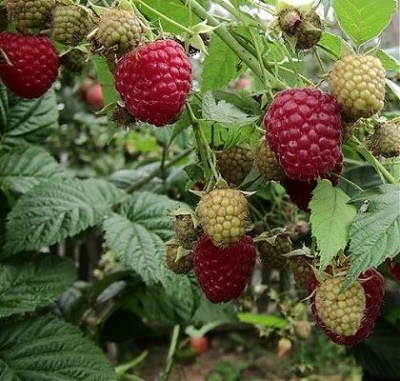
- Authors: Russia
- Repairability: No
- Berry color: dark red
- Taste: Sweet and sour
- Ripening period: average
- Berry weight, g: 4,0-6,0
- Yield: 4-6 kg per bush
- Frost resistance: high
- Yield rate: high
- Transportability: Yes
The number of raspberry varieties is growing every year. Breeders do not stop there and regularly develop new varieties with increased berry sizes and higher yields.
A striking example of a fruiting variety is the Red Queen raspberry. It is worth considering in more detail its features and methods of cultivation.
Description of the variety
Raspberry Krasnaya Koroleva is a non-repairable variety. It was bred by domestic breeders. The shrub has powerful stems. The peculiarity of the variety is the absence of thorns on the stem, which makes caring for the plant easier.
The Krasnaya Koroleva variety grows in many regions of the country, quickly takes root even in harsh conditions, and in warm autumn it is able to show signs of renovation. The pluses of raspberries include:
powerful bushes;
resistance to weather conditions;
self-fertility.
Among the disadvantages of the variety, the obligatory arrangement of trellises is distinguished, but experienced gardeners note that it is possible to do without them.
Ripening terms
Raspberries have an average period of fruit formation. Berries usually appear in early June when it comes to warm regions. In colder areas, ripening occurs a little later. It is interesting that the bush pleases with berries until mid-autumn.
Yield
One raspberry bush is capable of producing from 4 to 6 kg of berries.
Berries and their taste
The culture pleases gardeners with large berries, the maximum fruit weight is 6 g. The color of the fruit is dark red, the shape is blunt-conical. As for the taste, the berries are sweet and sour, exuding a smell during the rainy season. Jam, compotes and other desserts are made from raspberries.

Growing features
The culture does not grow well in the shade. To achieve large fruits and improve the taste of berries, it is worth planting a bush away from trees. The distance from the extreme tree to the raspberry seedling should be more than 4 meters. Otherwise, the Red Queen will bear a minimum of fruit.
Site selection and soil preparation
Raspberry Red Queen prefers open spaces where sunlight penetrates well. The landing site must be protected from winds, especially from the north. Shrubs should not be planted near tall trees.
The variety is planted in pre-prepared holes or trenches. The size of the holes should be 40x40 cm, the depth should be at least 50 cm.If we are talking about a trench, then its length should be 40 cm.At the same time, at the bottom of the hole, you need to make a small mound of soil, and also fertilize the soil in advance, where the seedling will be installed.



Watering and feeding
The Red Queen is highly sensitive to watering. In case of rare rains, it is worth organizing weekly watering for the plant. Otherwise, the bushes will dry out and will not bear fruit.
The amount of watering is determined by the climatic zone in which the crop grows. Basic rules for watering:
it is worth watering the plant with rain or settled water;
watering is carried out at the root;
you do not need to excessively moisten the soil;
it is recommended to add water in the morning or in the evening.
To achieve a high yield, you need to work hard. Particular attention should be paid to plant nutrition. It is necessary to use nutrients and mineral fertilizers as top dressing. In this case, you should focus on the following chart:
in the spring, wood ash, manure and humus should be added to the soil. And you can also fertilize the soil with organic materials to improve its fertility and help the seedlings take root;
in the first half of summer, when raspberries are blooming, it is necessary to treat the soil with urea;
closer to mid-August, during the active fruiting of the bush, it is recommended to apply complex fertilizers;
finally, in September, the soil should be fertilized with phosphorus-potassium fertilizing.


Frost resistance and preparation for winter
Raspberries tolerate winter well, if you approach the preparation of the bush correctly. Key recommendations:
in the autumn, before the onset of frost, you need to apply top dressing in the form of manure or potash fertilizer;
the next step is pruning the shrub to remove old branches that will not bear fruit next year;
then you need to collect young twigs and tie them to the trellis.
This approach will help the raspberries survive the winter and bear fruit next year.

Diseases and pests
The variety, like any raspberry, suffers from pest attacks and is susceptible to disease. Of course, breeders have tried to increase the resistance of the Red Queen, but you should not count on a miracle. The main pests of raspberries include:
aphids;
gall midge;
raspberry beetle;
nut-making.
Chemical preparations will help to overcome beetles: "Fufanon", "Actellik", "Iskra-M" and other means. Additionally, gardeners recommend changing the place of growing crops every 7 years and mulching the soil. If pests have infected the branches of the plant, they must be cut off and burned.

Unfortunately, raspberries, like other plants, do not bypass various diseases and pests.Only armed with the knowledge and the necessary means for this, you can cope with such troubles. To help the plant, it is very important to be able to recognize the disease in time and begin timely treatment.
Reproduction
The variety is propagated mainly by root shoots. This is a fairly simple method that most farmers use. And also the bush is propagated by cuttings. Finally, micro-cloning raspberry sprouts can be bought in specialized stores. This breeding option is suitable for industrialists.








































































